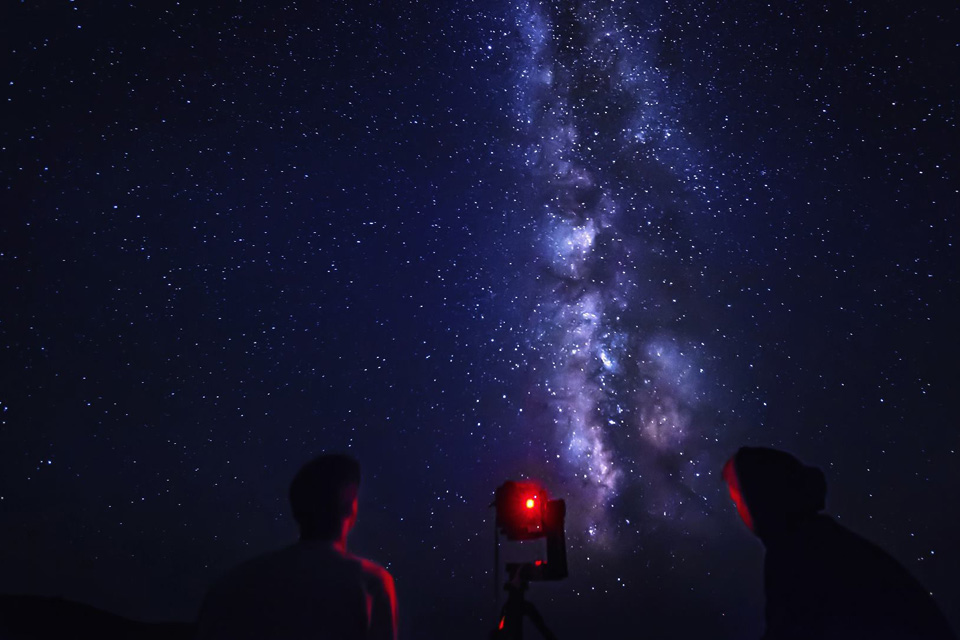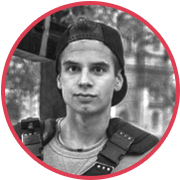
Time Catcher: Maciej Tomkow — On His Work as a Steadicam Operator
24 year old Maciej Tomkow is one of a handful of cameramen who shoot with a Steadicam (a camera stabilization system worn on your body) on rollerblades. In an interview with Bird in Flight he told us how his film about rollerbladers became more popular than the official video of EURO 2012, how hard it is to shoot time, and about the Holy Grail of post-production.

Last month I graduated from the cinematography department of an art school in Kraków, finished a course on working with Tiffen Steadicams in Oxford, and even now will continue studying. I want as many pros as possible to become my mentors and to share their experience with me.
Steadicam is a camera stabilizer mount for motion picture cameras that mechanically isolates it from the operator’s movement. The operator wears a vest which is attached to an isoelastic arm. This is connected by a multiaxis gimbal to the steadicam armature which has the camera mounted at one end and a counterbalance weight at the other. Working and operating steadicam is tough work – you need to maintain right posture, ensure proper hand positions on a gimbal, even the way you walk impacts the performance of a steadicam – it’s an “instrument” on which you play. Steadicam operator works mainly with the director of photography, so he needs to understand camera movement very well, it’s extremely important to keep framing as DOP wants.
I’ve been rollerblading since I was 10 and first put my hands on a camera when my friend came up with idea of making a rollerblading film „Sisiloco”. At that time I wasn’t filming a lot, just blading. When we were shooting I would push the REC button from time to time I had no idea of all the camera settings. In those days I filmed with small camera stabilizer called Glidecam for the first time. I was very excited about how stable the image was. Also I’ve spent hours with my friend while he was editing. Couple of months later I convinced my parents to buy me my fist DSLR camera – Canon 5D Mark II. That was 5 years ago.
I know that I’m one of only a few Steadicam operators in the world who work on rollerblades. However, I’m not concerned with fame — I’m too busy studying how to get better and shoot cooler films. Still, the technology I use is pretty unique. In 2013 I shot the film “Warsaw Halla.” Judging by comments and likes on the Internet, my film was better than a promotional film about EURO 2012 that cost €150,000 to make. All Polish media outlets were talking about my film, Gazeta Wyborcza printed an article that named “Warsaw Halla” the best city advert, they played it for six months on Warsaw public transport, and Pavel Tkachik (a Polish branding and marketing expert) found “Warsaw Halla” to be the best example of the city’s attractiveness.
Now my main occupation is shooting adverts. This gives me a chance to study and work, use cool equipment, and work with the pros. I love my work and I don’t treat it like a boring obligation. This is the most important thing in life — do whatever you do with passion.
{ “img”: “/wp-content/uploads/2015/03/tomkow01.jpg”, “text”:”” },
{ “img”: “/wp-content/uploads/2015/03/tomkow02.jpg”, “text”:”” },
{ “img”: “/wp-content/uploads/2015/03/tomkow03.jpg”, “text”:”” },
{ “img”: “/wp-content/uploads/2015/03/tomkow04.jpg”, “text”:”” },
{ “img”: “/wp-content/uploads/2015/03/tomkow05.jpg”, “text”:”” },
{ “img”: “/wp-content/uploads/2015/03/tomkow06.jpg”, “text”:”” },
{ “img”: “/wp-content/uploads/2015/03/tomkow07.jpg”, “text”:”” },
{ “img”: “/wp-content/uploads/2015/03/tomkow08.jpg”, “text”:”” },
{ “img”: “/wp-content/uploads/2015/03/tomkow09.jpg”, “text”:”” },
{ “img”: “/wp-content/uploads/2015/03/tomkow10.jpg”, “text”:”” }
Sometimes I do photography, but I’m more into cinematography. That’s not to say that I think photography is less interesting — you can do brilliant static shot by choosing the right focal length, light and composition.
I still don’t have my own Steadicam. I rent Zephyr and Ultra II models (sets start from $50,000 — ed.). For time-lapse shoots I use Canon 6D and 5D Mark III with a Canon L lens, and also DitoGear MultiAxis Motion Control which allows for 5axis programming, including dolly, pan and tilt, zoom and focus.
Drones are amazing and I already used them. Couple of years ago to make aerial shot you had to rent a helicopter – it was expensive and still is. Of course for highend quality shots you might want to use CineFlex or Shotover F1 system which is attached to a helicopter, but these are very expensive. Drone is just perfect for smaller projects.
Timelapse cinematography allows us to show things that are practically inaccessible to the human eye. It’s the ideal technique for shooting countrysides, architecture, cities and nature. I love to capture time, you know.
I watch a lot of movies shot in slowmotion, and have already found a camera, the Phantom Flex 4K, for my next project. There’s nothing sweeter than watching a clip in a clear, sharp picture with 4K resolution at 1,000 frames per second.
The so-called Holy Grail is collecting the material from day to night, or night to day, and this is also the most critical part of working with the material. First you need to sort the files, render a preview to see how the sequence looks. Then I move to RAW postprocessing in Adobe Camera RAW and LRTimelapse. I need to match exposure jumps between the shots, adjust white balance during the shot, contrast, shadows, blacks, whites and highlights levels – in this step I work on the look. When it’s done, I move to After Effects and import corrected sequence. I do minor adjustements like deflickering, noise reduction, retouch, image stabilization, and at the end I move to final render. When my file is ready, I can check how does the shot look in final. It’s not always perfect at once, so I move back to Adobe Camera RAW and LRTimelapse and keep working on it.
The “Treasures of Zakynthos” project was born out of another project called “Dream Walker,” which was about rope-jumping: 80 expeditions with technical participants invited from all over the world. 3rd edition took place at Navagio ‘Shipwreck’ Beach. I was shooting timelapses for their documentary film produced byCamL Studio. I was really excited to visit such a beautiful place. I didn’t plan to make my own, independent film at the beginning. The idea came up couple of days after we came back from Zakynthos. We left the island before the New Moon, I missed the best chance to capture Milky Way over Navagio Beach and many other magical places. I saw a photography of Milky Way over the Shipwreck from a local photographer Nick Kontostavlakis. I was amazed. I started to search on Vimeo, YouTube if there is any footage like this and I didn’t find any. This motivated me, made me wanna come back and make a timelapse film – a few minutes journey in the most epic places of the island.
My future plans is to get more and more experience in direction of photography, steadicam and also timelapse. It’s obvious that every cinematographer dreams about seeing his images on a big screen, so do I. I love working with steadicam and I that’s my plan for the future, but I could also travel around the world and capture the most beautiful places in timelapse. I don’t know yet which way I choose. The best would be both. I will definitely make a next timelapse project. I’m thinking about some places, but I won’t tell anything more. My goal is to buy a Steadicam Ultra II or GPI PRO. Hopefully one day… My most daring dream is an around the world timelapse project.
New and best




